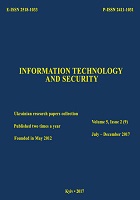Method of adaptive spatial coding of signals for non-stationary frequency-selective channels of wireless communication
DOI:
https://doi.org/10.20535/2411-1031.2017.5.2.136991Keywords:
Non-stationary, frequency-selectivity, MIMO, OFDM, spatial coding methods, mobile communication network, broadband access network.Abstract
General using of orthogonal-frequency multiplexing (OFDM) and multi-element antenna systems (MIMO) in wireless non-stationary frequency selective channels of mobile networks and broadband networks were considered. Methods of spatial block encoding (space-time (STBC), spatial-frequency (SFBC), spatial-frequency with high resistance to non-stationary (WHSTBC-CC) and spatial-frequency with increased resistance to frequency selectivity ( )) were analyzed and conditions for their efficient use were determined. It was shown that methods of spatial block coding are effective only for certain diapason of the values of statistical parameters of non-stationary and frequency selectivity (normalized Doppler frequency shift and mean square delay of signal propagation). The contradiction of the time influence and frequency selectivity on structural-parametric optimization of the technology MIMO-OFDM complicates objectively the development of the universal high-performance spatial encoding method for a wide class of non-stationary frequency-selective channels. The advanced method of adaptive spatial signal coding was proposed in order to increase the speed of the information transfer and quality of users service (reducing the probability of the information transmission error). The essence of the improvement is to integrate the channel noise protection of the channel (signal to noise ratio), normalize the value of the Doppler frequency shift, time and frequency correlation coefficients when determining the optimal situational application of SFBC, STBC, WHSTBC-CC, , that ensure the proper use of non-stationary frequency-selective channels with non-invariant parameters in time. The obtained scientific results can be used for modernization of existing and designing perspective wireless networks.
References
L. Hanzo, Jos. Akhtman, and Li Wang, MIMO-OFDM for LTE,WiFi, and WiMAX : coherent versus non-coherent and cooperativeturbo-transceivers. United Kingdom: IEEE, 2011.
Y.A. Hepko, V.F. Oleinyk, and Y.D. Chaika, The modern wireless networks: status and perspectives of development, Kyiv, Ukraine: “ЕКМО”, 2009.
M.G. Bakulin, V.B. Kreindelin, А.М. Shola, and А.P. Shumov, Technology OFDM. Moskow, Russia: Hot Line-Telecom, 2016.
S.A. Nizamaldeen, and T.M. Al-Qaradaghi, “A comparison between STBC-OFDM and SFBC-OFDM”, International Journal of Arts and Sciences, vol. 6, no. 5, рр. 157-166, 2014.
H.G. Yeh, ”Architectures for MIMO-OFDM system in frequency selective mobile fading channels”, IEEE Transactions on circuits and systems, vol. 62, no. 12, pp. 1189-1193, 2015.
doi: 10.1109/TCSII.2015.2498300.
A. Al-Dweik, S. Muhaidat, and F. Kalbat, ”Robust MIMO-OFDM system for frequency selective mobile wireless channels”, IEEE transaction on Vehicular Technology, vol. 64, iss. 5, pp. 1-11, 2014.
doi: 10.1109/TVT.2014.2340736.
H. Yeh, Y.K. Chang, and B. Hassibi, ”A scheme for canceling intercarrier interference through conjugate transmission for multicarrier communication systems”, IEEE Trans. Wireless Commun., vol. 6, no. 1, pp. 3-7, 2007.
М.I. Naumenko, and L.M. Pohrebniak, “Advanced method of space-time block coding frequency selective time-varying channels of systems of a military radio communication”, Collection of research papers VITI, no. 1, pp. 81-86, 2017.
N. Lee, and J. Kang, “Adaptive switching between space-time and space-frequency block coded OFDM Systems”, in Proc. IEEE Military Communications Conference, San Diego, pp. 7-13, 2008.
doi: 10.1109/MILCOM.2008.4753221.
A. Omri, R. Hamila, A. Hazmi, R. Bouallegue, and A. Al-Dweik, “Enhanced Alamouti decoding scheme for DVB-T2 systems in SFN channels”, in Proc. IEEE 22nd International Symposium on Personal, Indoor and Mobile Radio Communications, Toronto, pp. 2046-2050, 2011.
doi: 10.1109/PIMRC.2011.6139779.
A. Youssefi, N. Bounouader, Z. Guennoun, and J. El. “Adaptive Switching between Space-Time and Space-Frequency Block Coded OFDM Systems in Rayleigh Fading Channel”, International Journal of Communications, Network and System Sciences, no. 6., pp. 316 – 323, 2013.
doi: 10.4236/ijcns.2013.66034.
В. Skliar, Digital communication. Theoretical bases and practical application. Мoskow, Russia: Publishing house “Vyliams”, 2003.
Downloads
Published
How to Cite
Issue
Section
License
Copyright (c) 2020 Collection "Information technology and security"

This work is licensed under a Creative Commons Attribution 4.0 International License.
The authors that are published in this collection, agree to the following terms:
- The authors reserve the right to authorship of their work and pass the collection right of first publication this work is licensed under the Creative Commons Attribution License, which allows others to freely distribute the published work with the obligatory reference to the authors of the original work and the first publication of the work in this collection.
- The authors have the right to conclude an agreement on exclusive distribution of the work in the form in which it was published this anthology (for example, to place the work in a digital repository institution or to publish in the structure of the monograph), provided that references to the first publication of the work in this collection.
- Policy of the journal allows and encourages the placement of authors on the Internet (for example, in storage facilities or on personal web sites) the manuscript of the work, prior to the submission of the manuscript to the editor, and during its editorial processing, as it contributes to productive scientific discussion and positive effect on the efficiency and dynamics of citations of published work (see The Effect of Open Access).

